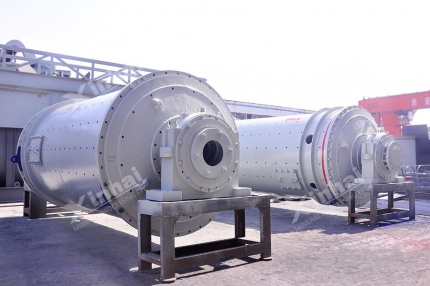When the ball mill is running, it will encounter some problems of material throwing at the discharge port, such as throwing out unground broken materials, and the amount of material thrown out is relatively large, which not only increases the power consumption of grinding materials, but also increases the labor intensity of personnel, seriously affecting the production progress of the entire dressing plant. Then how to solve this problem?

In fact, during the production process, many mine owners may have encountered the problem of material throwing at the discharge port of the ball mill. The reason why this problem occurs is basically due to one or several reasons that lead to insufficient output power of the ball mill, resulting in the material is thrown away from the discharge port. Below, the editor will give you a detailed understanding of the major causes of this problem and provide corresponding solutions to help you solve the problem of material throwing at the discharge port of the ball mill as soon as possible.
Use the table of contents below to navigate through the guide:
01The large particle size of the material at the feed port
Excessively large material particles will place additional burden on the grinding machine, and individual oversized material particles are not easily crushed by steel balls, which will reduce the output power of the ball grinding machine and increase the power consumption of the machine. At the same time, materials are continuously fed into the barrel of the ball mill. At this time, the materials that are not crushed will be thrown out of the ball mill outlet.
Solution: During operation, the ball mill operator should closely monitor the particle size of the material on the feeder. If it is found that the particle size exceeds the designed upper limit, the feed should be immediately reduced or stopped, and corresponding measures should be taken to ensure the feed. The particle size of the material is qualified.

02The replenishment of steel balls in the ball mill is insufficient or not timely
Due to the long-term operation of the mill, the steel balls wear violently, the diameter decreases, and the impact force also weakens accordingly. If the steel balls in the ball mill are not replenished in time, the output power of the machine will be insufficient.
Solution: In order to maintain a certain ball filling coefficient and steel ball diameter, the machine operator should regularly add qualified steel balls to the ball mill according to the current of the mill and the cumulative amount of grinding materials to reduce wear and maintain the ball charge filling rate.
03The size ratio of the added ball mill steel balls is unreasonable
According to the recommendations of professional ball mill manufacturers, the steel balls added to the mill each time are generally the upper limit of the designed size. However, if there is no shortage of steel balls, the output power of the grinder is still difficult to reach the output power when it was first put into operation, and the material will be thrown out. This shows that it is necessary to further adjust the size ratio of the ball mill steel balls.

Solution: Usually, the diameter of the small steel ball should be 13%-33% of the diameter of the large steel ball. Generally, the small steel ball accounts for 3%-5% of the mass of the large steel ball, and in principle, the amount of small steel balls should be ensured. Does not affect the filling rate of large steel balls. Therefore, ball mill operators should strictly follow the size ratio given by the grinding machine manufacturer and cannot blindly add.
04The inner lining plate of the ball mill barrel is damaged
The perfect barrel lining plate of the ball mill can increase the friction coefficient between the steel balls and the lining plate, which is beneficial to lifting the steel balls and materials and improving the processing capacity of the mill. For seriously worn lining plates, there is a large relative sliding between the steel balls and the lining plates. Therefore, more energy will be consumed in the friction between the steel balls and the lining plates and cannot be used to lift the steel balls, resulting in The output power of the mill is significantly reduced, thereby throwing out the material.
Solution: When the lining plate of the ball mill is damaged or falls off, the impact sound can be clearly heard on the spot. If this happens, the mill should be stopped as soon as possible and the damaged lining plate should be dealt with immediately to avoid large-scale damage to the mill lining plate.

In addition, during daily maintenance and operation, ball mill operators need to understand the ratio of mill lining plates to steel balls, and select the corresponding size and quantity of steel balls based on the ratio (the hardness ratio of conventional ball mill lining plates to steel balls is about 1:0.8), at the same time, select the appropriate ball mill lining according to the type of minerals, control the hardness of the lining and the steel balls, and make a reasonable match of the steel balls and the lining to slow down the wear of the lining.

The above are the four main reasons for material throwing at the discharge port of the ball mill. In the production process, sometimes it is caused by a single reason, or it may be caused by multiple reasons, and the improvement methods are also different. Therefore, when adjusting the operation of the ball mill, the operator should distinguish the priorities and make adjustments step by step according to the specific reasons. It is forbidden to take multiple measures to adjust at the same time when the reasons are not clear.


 marketing@ytxinhai.com
marketing@ytxinhai.com  0086 13810327080
0086 13810327080 






































































































 CHAT
CHAT MESSAGE
MESSAGE




.jpg)


